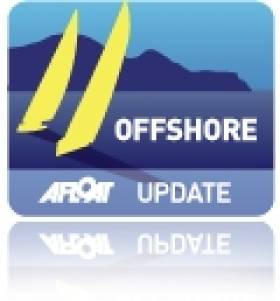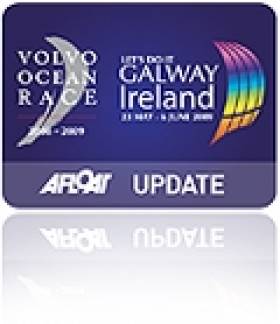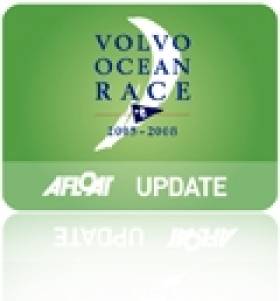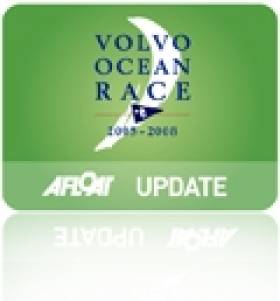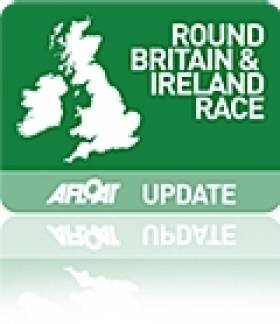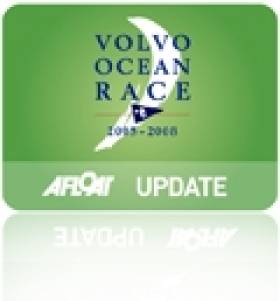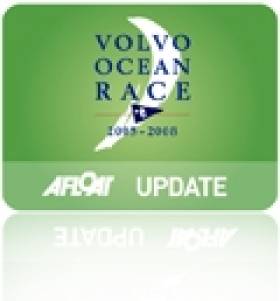Displaying items by tag: Volvo Ocean Race
Foxall Podcast from Volvo Ocean Race
Irish Sailing and Boating Regattas and Maritime Events
Reporting on the latest race news and regatta information is the one of the most important aspects of the Afloat.ie website. This page covers everything from round the world race stopovers, the arrival of the Tall Ships as well as domestic boat shows and a calendar of events.
Funding Remains Big Issue for Irish VOR Bid
After a struggle to complete the course both financially and on the water in the last Volvo Ocean Race two years ago, Green Dragon is to set sail again if the money can be found to fund a campaign. In this morning's Irish Times David Branigan indicates a potential skipper, Matt Humphries, has been advising the Galway based team but the real problem, as it always has been for the Irish boat, is finding the funding (ten million) to start the race in Spain next year. Full article HERE.
Green Dragon's Walker Signs for Abu Dhabi for 2011 Race
Appointed by the team's backer, Abu Dhabi Tourism Authority (ADTA), Walker, who steered Green Dragon from Galway two years ago, will lead an 11-strong crew hoping to stake its claim in one of the world's toughest, most extreme sporting challenges.
There is still no further news about how Ireland's entry for the race is shaping up or if work to bring the Green Dragon yacht up to speed has started.
ADTA, which was behind the emirate's successful bid to become a Volvo Ocean Race 2011-12 host city, believes Walker's appointment is a major coup for Abu Dhabi's inaugural title tilt.
"Ian is the lynchpin in the dream team we are determined to secure," explained Ahmed Hussein, Deputy Director General, ADTA. "His high profile sends a signal of the seriousness of our ambitions in a sport which will help us build international awareness of our long maritime pedigree and exceptional coastline and surrounding waters."
As design consultant on ADTA's planned, specially designed Volvo Open 70, Walker will be out to capitalise on years of experience to guide the outfit through nine-months of intense, head-to-head sailing over 39,000 nautical miles comprising four of the world's most treacherous oceans.
"The Volvo Ocean Race is mentally and physically exhausting. The whole project is quite daunting, but it is easier to comprehend having done the race before. I have huge respect for the yachts and the race and we will be as prepared as we possibly can be," said Walker, one of the world's leading helmsmen and tacticians.
"This is a fantastic opportunity to build a winning team both on and off the water. It is a huge challenge, yet we are confident we will compete for top honours. We have a unique opportunity to do something special with Abu Dhabi Ocean Racing.
"The emirate's participation is a huge step forward for sailing. Abu Dhabi is a great venue and the conditions are perfect for a sailing destination. This will certainly encourage other sailing events and championships to come to this part of the world and is already inspiring the local population to get fully behind sailing. The entire emirate, including nationals, is eager to embrace the race and get behind its team. This is going to be a fantastic journey."
ADTA and Walker, who lives in Southampton, UK, are also currently in the final stages of appointing the team's other crew members, and are committed to including a UAE national in the sporting team and another two on the shore team.
"I think it is crucial to have the right mix of youth and experience and I also like the idea of an internationally-represented crew. Obviously, you need the right mix of skills such as helming, trimming, bowmen, sailmaking, rigging and engineering, yet it is just as important to select people who will work well as a team. That is what we are aiming for with Abu Dhabi Ocean Racing," said the 40-year-old graduate of Cambridge University – one of the UK's 'Ivy League' institutions.
Knut Frostad, CEO of the Volvo Ocean Race commented, "We are very pleased to have Ian Walker back in our race and believe he will be an excellent skipper and leader for Abu Dhabi Ocean Racing. The host city is an excellent venue for sailing and hopefully this project will encourage and ignite passion for sailing within the region."
Walker, a father of two, was the skipper and sailing manager of the 2002 British America's Cup Team. He has accrued a wealth of sailing experience in a two-decade long career, which includes coaching the 2004 British Olympic Gold medal winning women's keelboat sailing team, winning the TP52 Global Championship, and leading the 2008-09 Volvo Ocean Race outfit, Green Dragon.
Plans are being progressed with Abu Dhabi stakeholders for the UAE capital's New Year 2012 hosting of the Volvo Ocean Race, when it sails into the sport's record books as the first Middle East stopover in the event's 37-year history.
Groupama in Lifeboat Fundraiser Race
The Groupama Volvo 70, with watch leader Damian Foxall, will be racing in aid of the French lifeboat service this weeken in a race created and organised since 2005 by French sailor Damien Grimont. The SNSM (Originally the Saint Nazaire St Malo) aims to promote safety at sea and support the volunteers, who rally together their members on a daily basis to offer assistance or emergency help to sailors.
Originally the SNSM record ran between Saint Nazaire and the pirate city of Saint Malo, but the route has since changed. This Sunday sailors will be required to race between Saint Nazaire and the pretty port of Sainte Marine, situated at the mouth of the Odet river.
Open to all types of boats measuring in excess of 6.50 metres, the record offers three courses, each of which relate to the speed of the participants and range between 180 and 360 miles.The largest boat at the start, Groupama 70 will have to make two return trips between Saint Nazaire and Sainte Marine, as is the case for the trimaran Gitana 11 skippered by Yann Guichard.Besides these two big names, no fewer than 56 competitors will take Sunday's start close to the port's eastern jetty between 1300 and 1400 hours local time.
Aboard Groupama 70, Franck Cammas has gathered together a large part of the crew who recently participated in the Transmanche race. Along with Jean-Luc Nélias, in charge of the navigation, we will find watch leaders Damian Foxall and Laurent Pagès, as well as Sébastien Josse, Erwan Israel, Sébastien Marsset, Yann Riou, Mike Parmenter, Philipp Harmer and Martin Krite. Another notable presence onboard comes in the form of Eurosport cameraman, Jérôme Dubarry.
Having to leave her home port of Lorient on Friday morning, Groupama 70 is expected into Saint Nazaire that same afternoon. As such the crew will, like the general public, have the opportunity to enjoy some sea rescue exercises performed by the SNSM, as well as a free concert given by the National Orchestra of the Pays de la Loire and a group called Jazz Band, who will provide an original interpretation of Tchaikovsky's "Nutcracker Suite".
"More than just a competition, the SNSM record is becoming a genuine festival of the sea for sailors on all manner of boats. Its popularity is a reflection of the responsibility we feel for supporting this organisation, which gives it all without a moment's hesitation, in what are at times difficult conditions. At Groupama we're naturally sensitive to this cause, which is why we won't solely be focusing on the sporting aspect when we take the start aboard Groupama 70. This event will also give us the chance to compare our performances with those of five participating IMOCA 60s and continue our preparation for the next Volvo Ocean Race" stated Franck Cammas, who will be joining his crew on Saturday evening, once he's had time to go out on the maxi trimaran Groupama 3, which has recently been revamped for solo sailing.
Foxall & Groupama to race Round Britain & Ireland
Damian Foxall and the Groupama crew have announced that the Shetland Round Britain and Ireland forms a major part of their Volvo Ocean Race preparation.
"We are going into the Transmanche across the channel race this month and then another race in June," said Foxall, "and then we are planning and it is all built up to the Round Britain and Ireland in September.”
Foxall has been heavily involved in selecting the Groupama team for the Volvo Ocean Race, a process that is nearly complete.
“We have more or less chosen our crew,” says Foxall. “We still have to confirm one or two slots, but we’ve started sailing with most of the guys already. By the end of September we want to have signed off the crew.”
“It was very important for us not to waste time," continues Foxall. "Even though you realise that last November the race might have seemed quite a long way away, as you get into it you realise that the race is already on. We are already coming up on deadlines with regard to the design and build of the new boat, like all the other teams are.
“So the time we spend on the water now, preparing the design and filling in the gaps with regards to what we know about the current boats and where we want to go with the new boats - it is a very important stage. So right now we are making decisions that will have basically a fundament bearing on the race results.”
This mixing of cultures has extended into the technical side of the campaign, for according to Foxall they have three sailmakers who were with other VOR teams in 2008-09. “In all areas - hether it is the sails, rig, boat, etc - most of the team has experience in working in both France and on the international circuit. That is hopefully one of our strong points.
Foxall has openly expressed disappointment with his three VOR campaigns to date, but feels that Groupama skipper Franck Cammas' involvement and enthusiasm for the project shows that the race has come of age.
"I am pretty motivated. I think the important thing from my point of view is that Franck [Cammas] and the sailing team proposed to Groupama the Volvo Ocean Race as a viable event and that shows the evolution of the VOR – especially in this edition where they believe it has got marketing and sporting value and the racing will be won on the water and not just with a chequebook.”
The full interview with Damian Foxall appears on the Volvo Ocean race homepage here
Groupama - The Green Team?
It's still more than a year until the start of the next Volvo Ocean Race, but we're aready looking at the runners and riders. With Groupama having snaffled two of the most experienced Irish heads in the game, namely Damian Foxall and boatbuilder Killian Bushe, there's enough emerald isle involvement to keep us interested in this Biscay-based boat. With no movement yet (as far as we know) on the proposed Irish team, they're the only group on the go within a decent radius.
Check out the below video to see the 'greening' of Groupama as they removed the Ericsson 4 livery and prepared to show their true colours.
Groupama plan includes Irish duo
Volvo Ocean Race veteran Damian Foxall and Killian Bushe, who has built the winning boat in the race on three occasions, are part of the team that hope to assist Franck Cammas' Groupama team to win the Volvo Ocean Race. Foxall is part of Cammas' core senior crew on board the boat, and has been involved in crew selection and campaign management from the outset. Bushe will spearhead the build of the boat from a French boatyard.
The French entry will be skippered by offshore specialist Franck Cammas. Speaking at an official event at Eric Tabarly's Cite de la Voile in Lorient, Cammas confirmed that the team already has a strong core of people working on the project."The challenge we've committed ourselves to is a sizeable one," says Cammas. "Since 1993 and Eric Tabarly, not a single French team has participated in the Volvo Ocean Race.
"Up against the top crews from New Zealand, America, Spain and Ireland, it's going to be an intense battle. We're just rediscovering monohulls and we still have a lot to learn.
"However, we're going about it with as much enthusiasm, seriousness and humility as possible. Thanks to Groupama's commitment, we were the first to put our team together."
Cammas's squad comprises a blend of experienced Whitbread/Volvo specialists and established members of the Groupama sailing programme. "Making up my entourage are Volvo specialists like Damian Foxall, Ben Wright, Luc Gellusseau, Herve Le Quilliec and Killian Bush who are joining together with long-term stalwarts of the Groupama team like Stephane Guilbaud, Pierre Tissier, Loic Dorez, Yann Riou and Olivier Mainguy," Cammas said.
Argentinean Juan Kouyoumdjian, the designer of the winning boats in the last two editions of the Volvo - ABN AMRO ONE (2005-06) and Ericsson 4 (2008-09) - has been chosen as designer for Groupama's new Volvo Open 70 - Groupama 4.
With the purchase of Ericsson 4, winner of the 2008-09 Volvo Ocean Race, the Groupama team has an ideal platform for training and development. Re-christened Groupama 70, the Koujoumdjian design is performing intensive sea trials off Lorient.
"Unfortunately we didn't have the time to involve the excellent French architects in the work, as they are also only just discovering the restrictions of the Volvo Open 70 rule," said Cammas.
"As such we opted for Juan Koujoumdjian, who is based in Valencia. However, it's actually in nearby Vannes, at the Multiplast yard, that Groupama 4 will be built. This will represent 40,000 man hours and we know the team there well because we built the maxi trimaran Groupama 3 with them."
Earlier this year, Cammas and his crew aboard the maxi trimaran Groupama 3 claimed the Jules Verne Trophy for sailing non-stop round the world - and broke through the 50-day barrier in the process.
Groupama 3's circumnavigation took 48 days 7 hours, 44 minutes and 52 seconds to beat the previous mark, set by Bruno Peyron's Orange 2 in 2005, by 2 days 8 hours, 35 minutes and 12 seconds.
With work having started on the new Volvo Open 70 in the last few days, construction will take 10 months until her scheduled launch on 15 March 2011.
In the meantime, Cammas will also take part in the Route du Rhum La Banque Postale aboard Groupama 3 but adapted to solo sailing, as well as the Extreme Sailing Series Europe aboard Groupama 40.
Groupama's entry extends a rich history of French links with the Whitbread/Volvo. In total there have been 21 French boats in the race and nearly 300 French sailors down the years.
O'Rourke the underdog enters the race
It has been confirmed that Ireland will have a second entry in the Volvo Ocean Race. Fastnet winner, twice Afloat sailor of the year, and national offshore-sprint hero Ger O’Rourke will use the title-holding boat, ABN Amro 1 (aka Black Betty) to take on the new generation of VO70s. Let speculation commence, says Markham Nolan.
Second Irish entry in the Volvo Ocean Race
The Irish Times reports this morning has confirmed that a second Irish entry in to the Volvo Ocean Race (VOR) will be made this week following the purchase of the winning boat from the 2005/6 race by offshore sailor Ger O'Rourke.
O'Rourke was crowned Afloat sailor of the year in 2007, becoming the first sailor to win the coveted trophy twice.


























